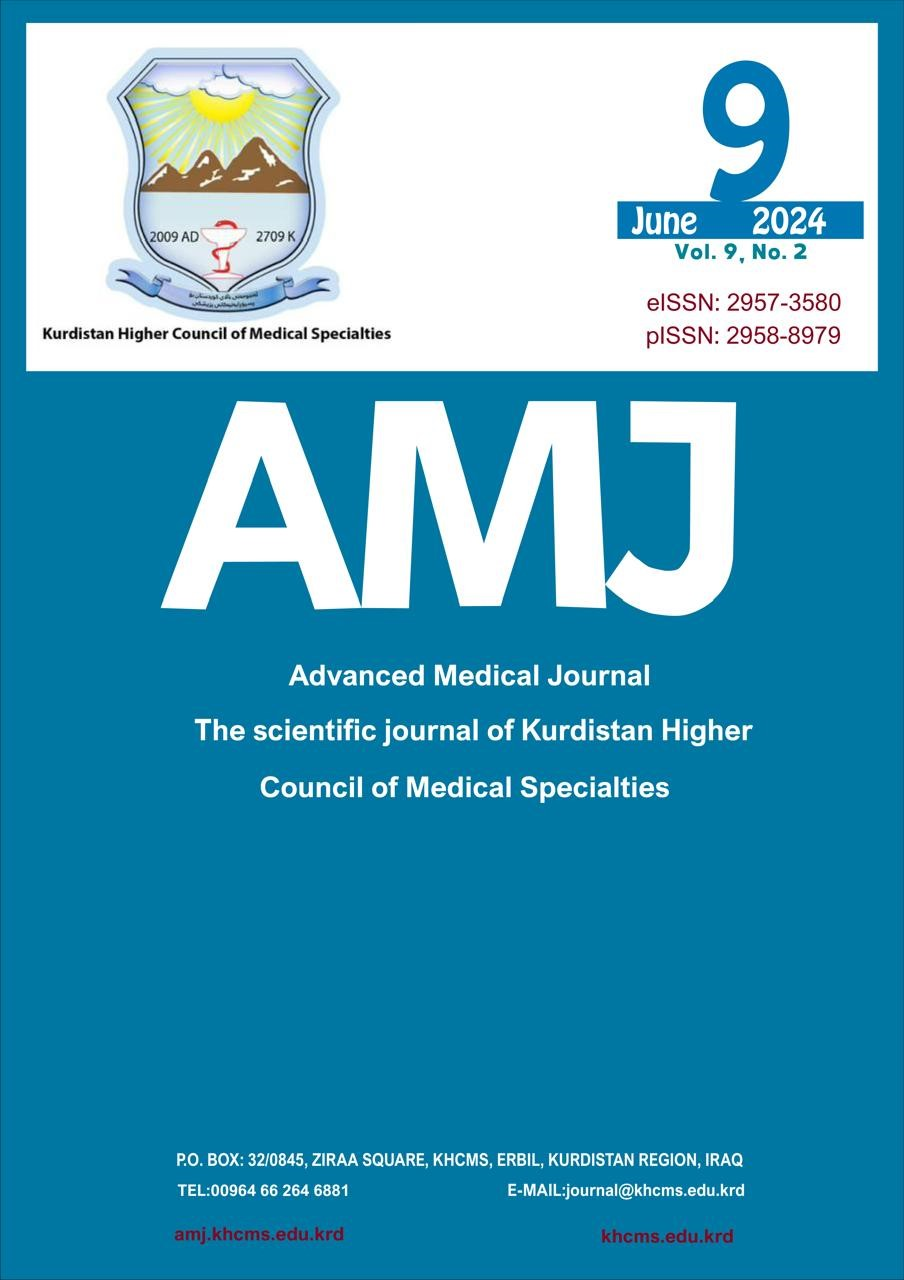Efficacy of intra lesional injection of 5-flourouracil on keloid scar: A prospective open clinical trial
DOI:
https://doi.org/10.56056/amj.2024.263Keywords:
Antineoplastic agent, Monotherapy, Prospective-clinical trial study, Skin disorderAbstract
Background and objectives: The management of keloids stayed unsatisfactory. Intralesional 5-fluorouracil has not been broadly and intensively studied as a monotherapy in the treatment of keloids worldwide. So, the aim of this study was to evaluate the efficacy and safety of intralesional injection of 5-flourouracil in patients with keloids.
Methods: In this prospective clinical trial study, a total of 20 patients aged >18 years at Shahid Jabar Dermatological Teaching Center, Sulaimaniyah, Iraq, from January 2022 to August 2022 were enrolled. Patients were treated at 1-week interval with intralesional injection of 5-flurouracil (50 mg/mL) at maximum of 6 sessions. Average injection volume was 0.2 mL/cm2. All patients were followed up for 6 months.
Results: Most of the patients were aged <50 years (90%) with no family history of keloid (75%). Additionally, 45% of patients had keloid in the trunk region with a size of ?10 cm2 (65%). Most patients (80%) had the disease for ?5 years that caused by inflammation (55%), especially skin type IV (65%). After 6 sessions of treatment, 70% of patients showed moderate improvement, while 30% of patients showed minimum improvement. The main adverse effects after 6 sessions of treatment were hyperpigmentation in 3 patients, bullae in 2 patients, and tissue sloughing only in 1 patient. A significant correlation was found between the patient’s response and age/keloid location. Moreover, mean Redness, Elevation, Hardness, Itching, and Tenderness score after treatment was significantly lower than before treatment (p<0.001).
Conclusions: Our results concluded that 5-flurouracil is a safe and effective therapy for the treatment of keloids.
Downloads
References
Berman B, Maderal A, Raphael B. Keloids and hypertrophic scars: pathophysiology, classification, and treatment. Dermatol Surg. 2017;43:S3-S18.
Sharquie KE, Al?Dhalimi MA. Keloid in Iraqi patients: a clinicohistopathologic study. Dermatol Surg. 2003;29(8):847-51.
Glass II D. Current understanding of the genetic causes of keloid formation. J Investig Dermatol Symp Proc. 2017;18(2):S50-S53.
Mofikoya B, Adeyemo W, Ugburo A. An overview of biological basis of pathologic scarring. Niger Postgrad Med J. 2012;19(1):40-5.
Kim H-D, Hwang S-M, Lim K-R, et al. Recurrent auricular keloids during pregnancy. Arch Plast Surg. 2013;40(01):70-2.
Wang JC, Fort CL, Hom DB. Location propensity for keloids in the head and neck. Facial Plast Surg Aesthet Med. 2021;23(1):59-64.
Boahene K, Brissett AE, Jones LR. Facial plastic surgery controversies: keloids. Facial Plast Surg Clin. 2018;26(2):105-12.
Sharma S, Bassi R, Gupta A. Treatment of small keloids with intralesional 5-fluorouracil alone vs. intralesional triamcinolone acetonide with 5-fluorouracil. J Pak Associ Dermatol. 2012;22(1):35-40.
Zhu Z, Kong W, Wang H, et al, Clinical status of hospitalized keloid cases from 2013 to 2018. Burns. 2022;48(8):1874-84.
Kontochristopoulos G, Stefanaki C, Panagiotopoulos A, et al, Intralesional 5-fluorouracil in the treatment of keloids: an open clinical and histopathologic study. J Am Acad Dermatol. 2005;52(3):474-9.
Saki N, Mokhtari R, Nozari F. Comparing the efficacy of intralesional triamcinolone acetonide with verapamil in treatment of keloids: A randomized controlled trial. Dermatol Pract Conceptual. 2019;9(1):4.
Bijlard E, Steltenpool S, Niessen FB. Intralesional 5-fluorouracil in keloid treatment: a systematic review. Acta DV. 2015;95(7):778-82.
Srivastava S, Patil AN, Prakash C, et al, Comparison of intralesional triamcinolone acetonide, 5-fluorouracil, and their combination for the treatment of keloids. Adv Wound Care. 2017;6(11):393-400.
Uzair M, Butt G, Khurshid K, et al, Comparison of intralesional triamcinolone and intralesional verapamil in the treatment of keloids. Our Dermatol Online. 2015;6(3):280.
Shah VV, Aldahan AS, Mlacker S, et al, 5-fluorouracil in the treatment of keloids and hypertrophic scars: a comprehensive review of the literature. Dermatol Ther. 2016;6(2):169-83.
Mustoe TA, Cooter RD, Gold MH, et al, International clinical recommendations on scar management. Plast Reconstr Surg. 2002;110(2):560-71.
Sharquie K, Noaimi A, Al-Karhi M. Debulking of keloid combined with intralesional injection of methotrexate and triamcinolone versus intralesional injection of methotrexate and triamcinolone. J Clin Dermatol Ther. 2014;1(3):8-21.
Prabhu A, Sreekar H, Powar R, et al. A randomized controlled trial comparing the efficacy of intralesional 5-fluorouracil versus triamcinolone acetonide in the treatment of keloids. J Sci Soc. 2012;39(1):19.
Saha AK, Mukhopadhyay M. A comparative clinical study on role of 5-flurouracil versus triamcinolone in the treatment of keloids. Ind J Surg. 2012;74(4):326-9.
Srivastava S, Patil A, Prakash C, et al, Comparison of intralesional triamcinolone acetonide, 5-fluorouracil, and their combination in treatment of keloids. World J Plastic Surg. 2018;7(2):212.
Sun LM, Wang KH, Lee YC. Keloid incidence in Asian people and its comorbidity with other fibrosis-related diseases: a nationwide population-based study. Arch Dermatol Res. 2014;306(9):803-8.
Noishiki C, Hayasaka Y, Ogawa R. Sex differences in keloidogenesis: an analysis of 1659 keloid patients in Japan. Dermatol Ther. 2019;9(4):747-54.
Liu R, Xiao H, Wang R, et al, Risk factors associated with the progression from mild keloids to severe keloids. Chin Med J. 2022;135(07):828-36.
Lu W-s, Zheng X-d, Yao X-h, et al, Clinical and epidemiological analysis of keloids in Chinese patients. Arch Dermatol Res. 2015;307(2):109-14.
Kouotou EA, Nansseu JR, Omona Guissana E, et al, Epidemiology and clinical features of keloids in Black Africans: A nested case–control study from Yaoundé, Cameroon. Int J Dermatol. 2019;58(10):1135-40.
Shaheen A, Khaddam J, Kesh F. Risk factors of keloids in Syrians. BMC Dermatol. 2016;16(1):1-11.
Belie O, Ugburo A, Mofikoya B. Demographic and clinical characteristics of keloids in an urban center in Sub-Sahara Africa. Niger J Clin Pract. 2019;22(8):1049-54.
Nanda S, Reddy BSN. Intralesional 5?fluorouracil as a treatment modality of keloids. Dermatol Surg. 2004;30(1):54-7.
Bijlard E, Kouwenberg C, Timman R, et al, Burden of keloid disease: a cross-sectional health-related quality of life assessment. Acta DV. 2017;97(2):225-9.
Sharma S, Vinay K, Bassi R. Treatment of small keloids using intralesional 5-fluorouracil and triamcinolone acetonide versus intralesional bleomycin and triamcinolone acetonide. J Clin Aesthet Dermatol. 2021;14(3):17.
Hietanen K, Järvinen T, Huhtala H, et al, Treatment of keloid scars with intralesional triamcinolone and 5-fluorouracil injections–a randomized controlled trial. J Plastic Reconstr Aesthet Surg. 2019;72(1):4-11.
Alexandrescu D, Fabi S, Yeh LC, et al, Comparative Results in Treatment of Keloids With Intralesional 5-FU/Kenalog, 5-FU/Verapamil, Enalapril Alone, Verapamil Alone, and Laser: A Case Report and Review of the Literature. J Drugs in Dermatol. 2016;15(11):1442-7.
Downloads
Published
How to Cite
Issue
Section
License
Copyright (c) 2024 Banoo Dhahir Latif, Mohammed Yousif Saeed , Darseem Muhammed Abdulla

This work is licensed under a Creative Commons Attribution-NonCommercial-ShareAlike 4.0 International License.
The copyright on any article published in AMJ (The Scientific Journal of Kurdistan Higher Council of Medical Specialties )is retained by the author(s) in agreement with the Creative Commons Attribution Non-Commercial ShareAlike License (CC BY-NC-SA 4.0)








